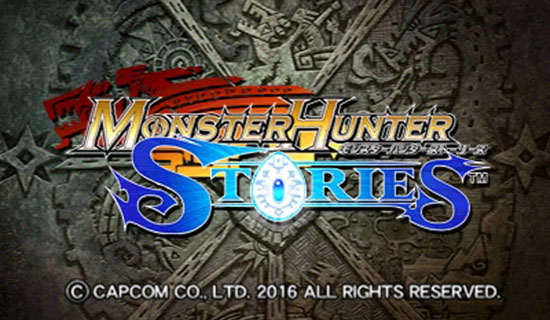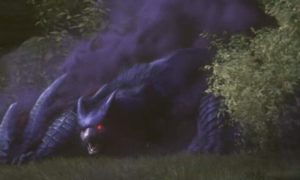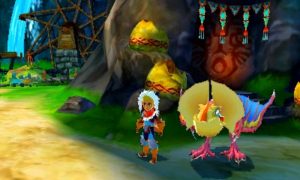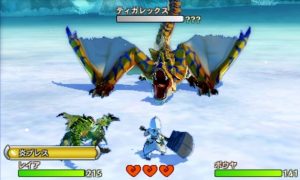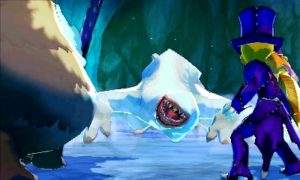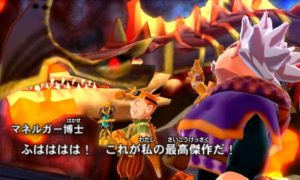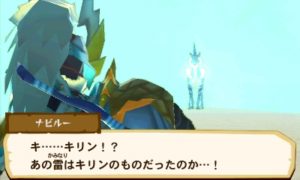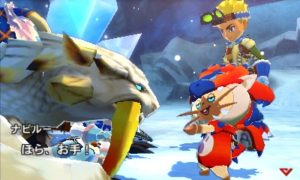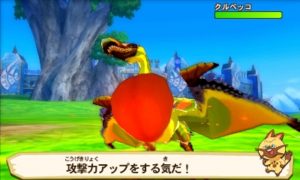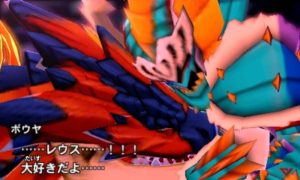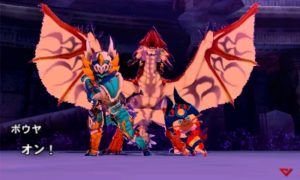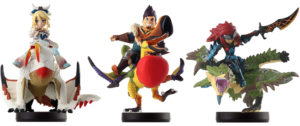The Monster Hunter franchise was no stranger to spin-off games by 2016. Not counting any of the handful of mobile games available (very few of which were in the style of a traditional Monster Hunter game), there were already three different MonHan Nikki: Poka Poka Airu Mura games (two on the PSP and one on the 3DS) and Airu de Puzzle (PSP). They were all very different experiences from the mainline Monster Hunter games in both visuals and game-play, and were all developed by studios other than Capcom (The Poka Poka Airu Mura games by From Software, and Airu de Puzzle by Natsume). But it was a little surprising that there hadn’t yet been an attempt to make a JRPG that took place in the Monster Hunter universe. Capcom clearly took notice of this, and a JRPG is just what we would get from developer Marvelous in Monster Hunter Stories.
MH Stories tells the tale of three kids from Hakumu Village (one of which is your own created main character), a village in which you can choose to become a rider of monsters. If you pass a test given to you by the village elder, you’re given a stone that allows you to form bonds with monsters, befriending them as partners (the game refers to them as “Otomon”, a combination of “otomodachi” (friend) and “monster”. It’s also similar to “otomo Airu”, the cats that you can take out on hunts with you in the mainline games ) instead of hunting them and carving them up for armor and weapons. Hunters still exist elsewhere in the world though, and riders are a very foreign concept to them. The main character passes this test and teams up with Naviru (an Airu with a mysterious past that helps you navigate your way through your journey) and Reus (an adorable one-eyed Rathalos) to travel the world and unravel the mystery of what’s causing monsters to turn aggressive. And since Stories features young protagonists and is a story-focused game, it was the perfect time for a Monster Hunter anime tie-in series. So Monster Hunter Stories Ride On, began airing the very same month on Fuji TV. The story largely the same as the one found in the game but in greater detail, and with a more fleshed out (and not silent) main character named Ryuuto.
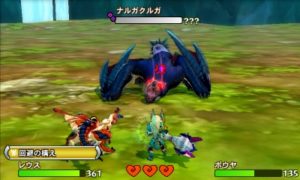
Not too surprisingly, Stories has adopted a Pokemon-like system in which you travel to various locations and encounter many of your favorite monsters. You battle them with your own party of monsters, using a less complex version of Pokemon’s rock-paper-scissors battle system: There are power, speed and technical attacks, along with various point consuming special techniques. These techniques allow you perform various buffs and de-buffs as well as elemental attacks. This is the main way in which knowing about the monsters from having played games in the series is a big benefit, as they tend to keep the same elemental weaknesses.
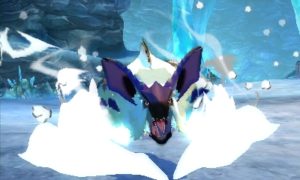
Capturing new monsters isn’t done with a ball though,but rather by performing another Monster Hunter appropriate activity: Going into caves and carrying out eggs from monster nests. Once you have some eggs, they can be hatched with the help of an egg-managing Airu found at any village or town, and see what new monsters you can add to your party. The eggs also come in different rarities, so don’t expect to get all of the most powerful monsters very easily. Different colored caves have a small chance of appearing in any area, resulting in rarer eggs. Much like in Pokemon, there’s a bit of a stat maxing meta game to be found here. A ritual that allows you to take monsters (and you’ll absolutely end up with a ton of duplicates) and sacrifice them is the primary means of improving other monsters stats (which is surprisingly Shin Megan Tensei-esque), as well as allowing them to inherit skills or special attacks using a grid-based system.
In addition to leveling up both your main character and party simply by fighting, you also have the option of accepting sub-quests via the quest board found in any town. And you should make use of it, since it sure beats traditional level grinding. Sometimes sub-quests involve killing X amount of a specific monster, sometimes just a single more powerful monster in a specific location, and sometimes gathering a specific number of an item (everyone’s favorite). In making it a point to do these and fight most of the stronger monsters that I randomly encountered, I found myself never having to grind in order to beat the story bosses.
Though it will occasionally chug for for short bursts (both in and out of 3D mode), this is one of the nicer looking games on the 3DS. The cartoony art style allows for a simple but appropriate design, and the 3D is worth keeping on pretty much all the time (on a New 3DS anyway). The in-game text and dialogue is all straightforward and doesn’t require a high level of Japanese proficiency to be able to read (there is furigana on everything). And since there’s a decent chance that this game may never be localized for any other territories, any Japanese-reading die hard Monster Hunter fans may want to check out the Japanese version.
Various pieces of free downloadable content were offered for Monster Hunter Stories: Tons of different sub-quests, various costumes for Naviru, armor for your main character and even Otomon. Much of the DLC was cross-overs with other shows or games, including Chibi Maruko chan, Puzzle & Dragons X, Kumamon (the mascot character for Kumamoto Prefecture), and The Legend of Zelda. Street passing can be used to obtain other rider’s cards (similar to the exchange of guild cards in the regular Monster Hunter games), and there’s even Amiibo support (along with six special Amiibos made just for this game) to get special monsters. Stories offers an online battle mode, though there’s really to it apart from a team versus team battle against another player. There’s also a lot of post game content to be had for those who want to collect and fight the most powerful monsters in the game.
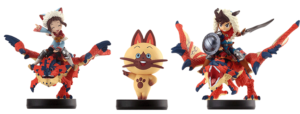
There really isn’t a lot to say about Monster Hunter Stories. If you’re in the mood for a nice simple RPG that won’t overwhelm you, or really enjoy RPGs that borrow systems from Pokemon, Monster Hunter Stories probably won’t steer you wrong. But there aren’t many reasons to choose it over Pokemon if you aren’t already invested in the world of Monster Hunter first. So much of its charm rests on affection for these monsters that it’s really a game made for existing fans of the series, with not much chance of pulling in new fans based on its own unique merits. It’s a simple and solid Pokemon-esque RPG that I had fun with and would absolutely recommend to Monster Hunter fans who aren’t Pokemon-phobic, but it doesn’t do Pokemon as well as Pokemon does Pokemon.
